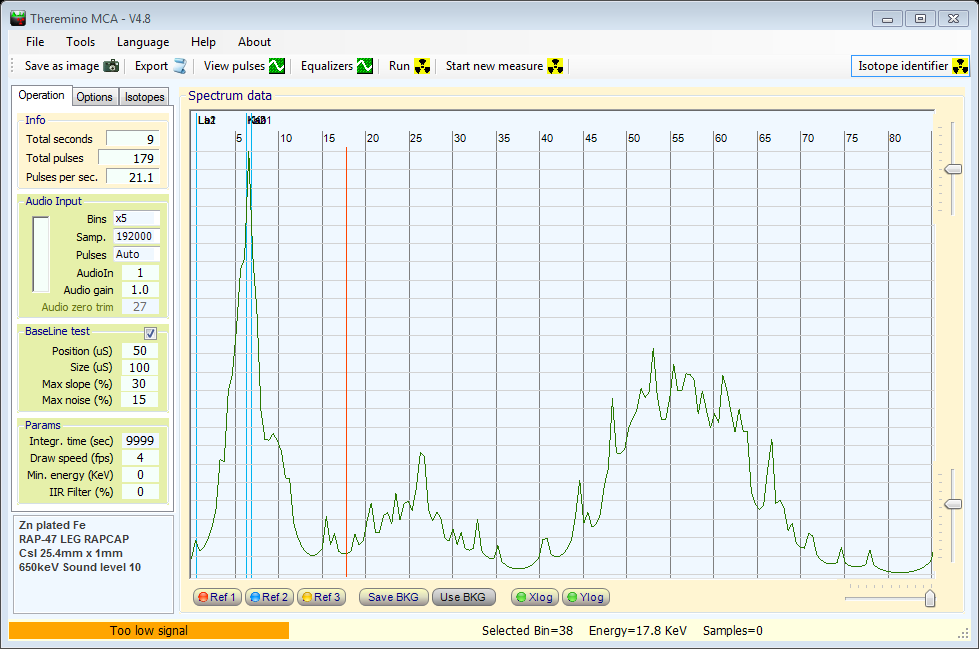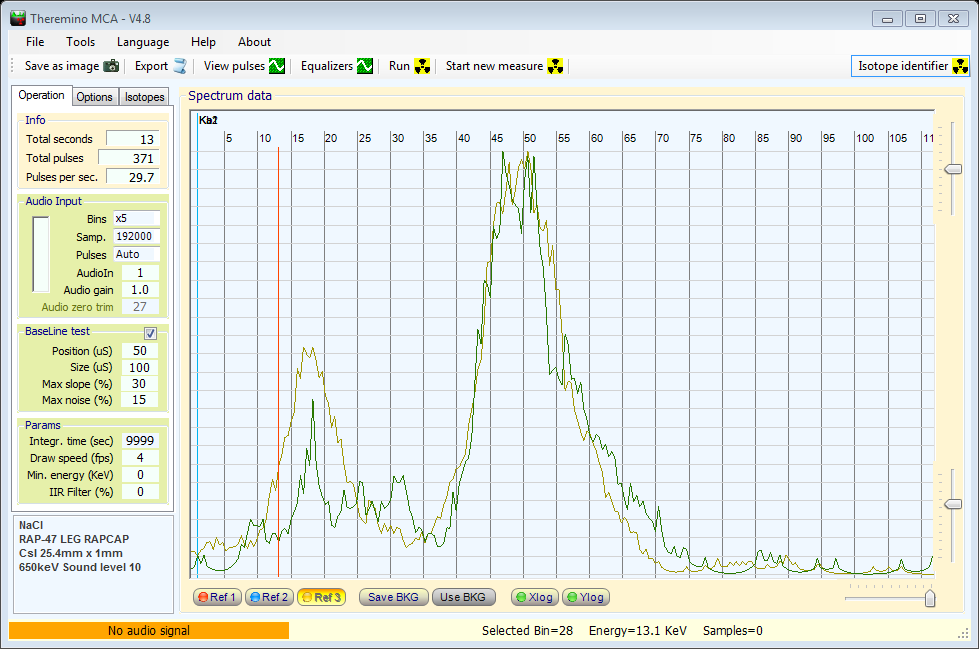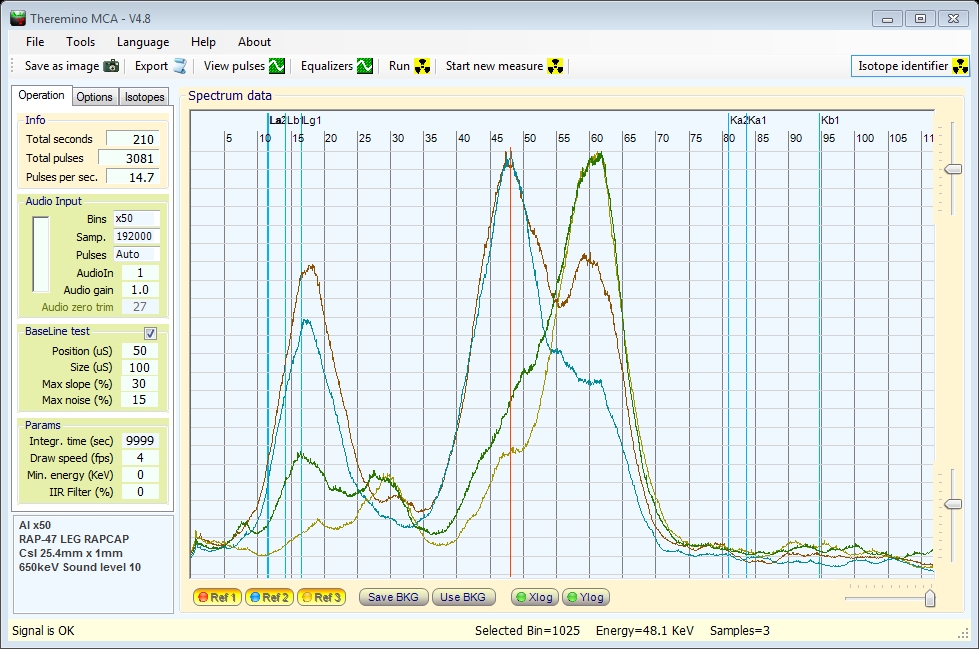The reason I started to experiment XRF
I first started to experiment XRF to check the low energy accuracy of my detector setup ( RAP-47 + Theremino Pmt Adapter + Theremino Mca ), and to learn how to use Theremino Mca so that I can do better translation of documents into Japanese.
And I wanted to check the low energy area because what I was seeing in Am241 spectrum with smoke detector wasn't something I expected. (And I'm not totally convinced, yet)
==> Am Spectrums
How many buttons do we need?
I've tried different configurations (number of buttons to use, geometry, blocking material, and different base line setting in Theremino Mca) to obtain best resolution, sensitivity, and lower noise.So far, it seems that just one button is enough to get good result, very quickly.
What is causing XRF? Alpha, beta, gamma, or combinations?
I don't know yet if it's Alpha, beta or gamma ray that is acting as the source of XRF excitation when I use Am241 (smoke detector) source.
I tried to check it by placing a paper in between button source and the material to block Alpha. I tried to block beta, as well. But it's hard to say, for now. I can say that gamma is definitely contributing. I'm not sure if Alpha and beta are contributing or not, yet.
I need to test more.
Distance between the button and the material
It can be a few millimeters to several millimeters, I would say.
It depends on the geometry of the setup, detector size, and so on, I guess.
Am241 Back ground
Currently (till I make proper shielding), I'm ignoring the Am241 back ground.
And the XRF peaks are usually distinct and bright enough (and often well bellow Am241 peaks).
And with the Compton scattering (or shift, typically of about 11KeV fr 59.5KeV Am241 peak), they give information about target density, etc.
It works like a sonar or radar, a bit.
- Unresolved mystery : I'm not totally sure yet what is causing the 17KeV peak. I guess it's coming from the combinations of following (and maybe others) and their Compton scattering:
- U XRF 16.4KeV
- Pa XRF 16.7KeV
- U XRF 17.2KeV
- Am XRF 17.6KeV
- Np237 17.74KeV
- Am XRF 18.85KeV
See Compton Scattering for more.
How to minimize back ground Am241 gamma (and XRF)
I'm still using the Jim's RAPCAP (placing Lead in front, and placing only one button), but thinking about making and testing something different.
I think it's important to have a bit (or more) of lead around the button to minimize the back ground while letting the desired XRF from the target.
Voltage for Rap-47
I'm using 660V, for now. (It's written 650v in the note of Theremino, but I just forgot to change it...)
Base line test setting
I'm still experimenting.
Right now, the setting of 50, 100, 30, 15 is doing good job.
I get good enough peak from Titanium (below 5KeV).
Results
Most of targets are placed in a thin plastic bag. So, there is slight echo from the bag. Some targets are pretty small. Some are thin, while others are thick.
Thick material usually give stronger echo of Compton shift.
In addition to things I've tested, previously (Xrf Spectrums, Xrf Flute Spectrums), I bought several more materials to test and to calibrate/verify my setup.
Small pieces of titanium pellets. (4mm diameter x 10mm. Only two of them)
I could get good peak from RAP-47 below 5KeV.
It's not noise, as I checked and rechecked with and without target, monitoring pulse shape sub window.

http://pico.dreamhosters.com/img/XRFp2/HISTOGRAM_2013_06_09_19_19_33-RAP-47-Titanium.txt
Half inch diameter Copper tube. (about 1mm thick)

http://pico.dreamhosters.com/img/XRFp2/HISTOGRAM_2013_06_09_19_20_37-RAP-47-Cu-Copper-tube.txt
Tin plated steel.

http://pico.dreamhosters.com/img/XRFp2/HISTOGRAM_2013_06_09_19_21_52-RAP-47-Sn-plated-Fe.txt
A piece of Zinc plated steel (for construction).

http://pico.dreamhosters.com/img/XRFp2/HISTOGRAM_2013_06_09_19_22_28-RAP-47-Zn-plated-Fe.txt
Zinc ingot. About 30mm diameter and 10mm thick at the center.

http://pico.dreamhosters.com/img/XRFp2/HISTOGRAM_2013_06_09_19_23_53-RAP-47-Zn-ingot.txt
Indium ingot of 20mm X 20mm and 2mm thick.

http://pico.dreamhosters.com/img/XRFp2/HISTOGRAM_2013_06_09_19_25_02-RAP-47-Indium-ingot.txt
Cadmium rod. Diameter of 12mm and 80mm long.

http://pico.dreamhosters.com/img/XRFp2/HISTOGRAM_2013_06_09_19_26_02-RAP-47-Cadmium-ingot.txt
Tiny Zirconium crystal. About 2mm X 3mm. Very small.

http://pico.dreamhosters.com/img/XRFp2/HISTOGRAM_2013_06_09_19_27_55-RAP-47-Zirconium.txt
Small pure silver ingot. 10mm X 10mm X 1mm.

http://pico.dreamhosters.com/img/XRFp2/HISTOGRAM_2013_06_09_19_29_18-RAP-47-Silver-ingot.txt
Scionix Holland NaI(Tl) detector.

http://pico.dreamhosters.com/img/XRFp2/HISTOGRAM_2013_06_09_19_32_22-RAP-47-NaI-Tl-detector.txt
Sanyo Old Ni-Hi battery. I'm not sure what I'm measuring... Not much Nickel.

http://pico.dreamhosters.com/img/XRFp2/HISTOGRAM_2013_06_09_19_37_05-RAP-47-NiHi-battery.txt
Chrome plated BNC connector. I thought it was Nickel plated, but I guess not.

http://pico.dreamhosters.com/img/XRFp2/HISTOGRAM_2013_06_09_19_39_52-RAP-47-BNC-connector.txt
5 cent and 10 cents Canadian coins.

http://pico.dreamhosters.com/img/XRFp2/HISTOGRAM_2013_06_09_19_40_29-RAP-47-Nickel-coins.txt
Back plate of an old watch case. I think it's mainly XRF from Cr plating.

http://pico.dreamhosters.com/img/XRFp2/HISTOGRAM_2013_06_09_19_42_19-RAP-47-Watch-back-plate.txt
Small PET water bottle. It shows Compton shift echo image.

http://pico.dreamhosters.com/img/XRFp2/HISTOGRAM_2013_06_09_19_52_58-RAP-47-Water-bottle-small.txt
Bigger PET water bottle.

http://pico.dreamhosters.com/img/XRFp2/HISTOGRAM_2013_06_09_19_56_41-RAP-47-Water-bottle-big.txt
Small pad lock made of bronze, etc.

http://pico.dreamhosters.com/img/XRFp2/HISTOGRAM_2013_06_09_20_03_55-RAP-47-Bronze-lock-Cu-etc.txt
An alligator cramp for battery. Plated with Cu, etc.

http://pico.dreamhosters.com/img/XRFp2/HISTOGRAM_2013_06_09_20_05_46-RAP-47-Cu-plated-Fe.txt
Bronze name tag. I thought I would see Sn (4KeV and 25KeV), but maybe it's a mixture of copper, zinc, steel?, etc.

http://pico.dreamhosters.com/img/XRFp2/HISTOGRAM_2013_06_09_20_07_47-RAP-47-Bronze-tag.txt
Retake of copper tube. I placed it slightly farther away from the button source.

http://pico.dreamhosters.com/img/XRFp2/HISTOGRAM_2013_06_09_20_11_31-RAP-47-Coppr-tube.txt
Zinc plated Steel plumbing pipe.

http://pico.dreamhosters.com/img/XRFp2/HISTOGRAM_2013_06_09_20_27_06-RAP-47-Zn-plated-Fe.txt
Thai rice. Ref3 (yellow) is Big water bottle. No visible sign of metal.
It's basically just Compton scattering.

http://pico.dreamhosters.com/img/XRFp2/HISTOGRAM_2013_06_09_20_32_36-RAP-47-Thai-rice.txt
Sea salt. I was trying to see if I'd see Na (1.04 and 1.07KeV)or Cl (2.6 and 2.8KeV).

http://pico.dreamhosters.com/img/XRFp2/HISTOGRAM_2013_06_09_20_33_47-RAP-47-NaCl.txt
KCl instead of NaCl , this time. I think we are seeing K (3.3 and 3.6KeV).

http://pico.dreamhosters.com/img/XRFp2/HISTOGRAM_2013_06_09_20_38_23-RAP-47-KCl.txt
It's a Bandaid with Ag. Not so conclusive (for detecting Ag).
I checked against the portion without Ag, and there is a good difference.
But I can't say that there is Ag, just seeing the result (without know it beforehand).

http://pico.dreamhosters.com/img/XRFp2/HISTOGRAM_2013_06_09_20_41_10-RAP-47-Elastplasto-Ag.txt
CsI (Tl) detector. I guess it's a mixture of Cesium and Iodine that we are seeing.
Compared to NaI detector that shows the peak below 30KeV, CsI detector has the peak at a bit higher energy because of Cesium (30.6 and 30.9KeV and about35KeV).
Iodine has the peaks at 28.3 and 28.6KeV (and 32.3KeV).
Both Iodine and Cesium have L shell below 5KeV (between 3.6 and 4.8KeV).

http://pico.dreamhosters.com/img/XRFp2/HISTOGRAM_2013_06_09_20_45_52-RAP-47-CsI-Tl-detector.txt
Yet another setting (x50 instead of x5)
With this setting, the result is more constant and reliable.
But we do miss small detail (as it takes longer and small things are buried).
Again, Zinc plated steel plate for construction.

http://pico.dreamhosters.com/img/XRFp2/HISTOGRAM_2013_06_09_23_00_55-RAP-47-Zn-plated-Fe-x50.txt
Cadmium rod.

http://pico.dreamhosters.com/img/XRFp2/HISTOGRAM_2013_06_09_23_14_32-RAP-47-Cd-x50.txt
Zinc ingot.

http://pico.dreamhosters.com/img/XRFp2/HISTOGRAM_2013_06_09_23_19_12-RAP-47-Zinc-x50.txt
Copper tube

http://pico.dreamhosters.com/img/XRFp2/HISTOGRAM_2013_06_09_23_24_41-RAP-47-Cu-x50.txt
Back ground

http://pico.dreamhosters.com/img/XRFp2/HISTOGRAM_2013_06_09_23_34_02-RAP-47-BG-al-x50.txt
Maple Sugar.
Ref3 (yellow) is back ground.
Most probably, no XRF peaks other than Compton drift echos.

http://pico.dreamhosters.com/img/XRFp2/HISTOGRAM_2013_06_09_23_38_25-RAP-47-Maple-Sugarl-x50.txt
Small water bottle
Ref3 (yellow) is back ground.
Most probably, no XRF peaks other than Compton drift echos.
But the echo pattern is different from that of Maple Sugar.

http://pico.dreamhosters.com/img/XRFp2/HISTOGRAM_2013_06_09_23_41_15-RAP-47-Water-bottle-S-x50.txt
I was trying to see if I can get Aluminum. I guess it's way too low.
It's a thick foil of about 0.3mm

http://pico.dreamhosters.com/img/XRFp2/HISTOGRAM_2013_06_09_23_56_43-RAP-47-Al-x50.txt
Another try for Aluminum. Thin, normal aluminum foil.
Thick or thin, Aluminum only creates slight echo for the lower one of two Am241 peaks.

http://pico.dreamhosters.com/img/XRFp2/HISTOGRAM_2013_06_10_00_03_03-RAP-47-Al-foil-x50.txt
Thai rice is giving echo image of Am241 pretty similar to small water bottle.
No heavy metal can be seen, but I doubt I can detect something unless it's highly contaminated.

http://pico.dreamhosters.com/img/XRFp2/HISTOGRAM_2013_06_10_00_05_35-RAP-47-Thai-rice-x50.txt
This is a very small piece (about 2mm x 3 mm) of Zirconium.
We should be able to get better result with bigger one.
And in this case, the peak is more than the echo from plastic bag and a sheet of paper attached to it. (Paper + plastic bag give about a half of the peak at 15KeV)

http://pico.dreamhosters.com/img/XRFp2/HISTOGRAM_2013_06_10_00_38_59-RAP-47-Zr-x50.txt